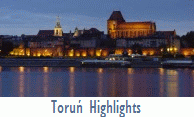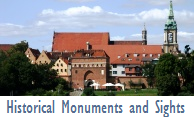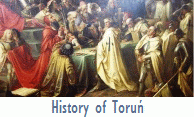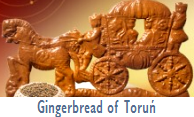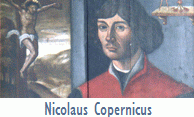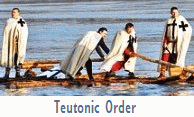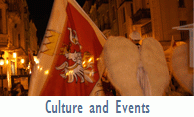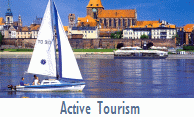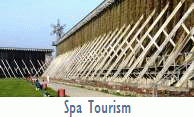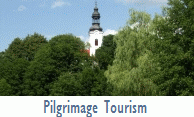|
Welcome to Toruń, one of the oldest and the most beautiful Polish cities. Here is the city famous for its remarkable monuments which have won the designation of the cultural heritage of mankind from UNESCO, as well as for its troubled and rich history. Lastly, but perhaps most importantly, the city is renowned for Nicolaus Copernicus and gingerbread. 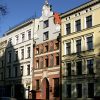 Medieval Lazienna St. | 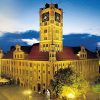 Old Town City Hall | 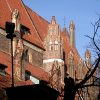 St. James Church | 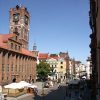 Old Town Market Sq. |
Toruń, an old Hanseatic centre, during the nearly eight centuries of its rich history played a significant role in creating political, economic and cultural history and tradition of Europe. Toruń’s surviving material and cultural heritage provides a conclusive proof of the former economic and political power of the city which was situated at the intersection of long-distance land and water trade routes. Since its foundation, Toruń had gradually developed into an increasingly bigger European trade centre. As early as 1280, the city joined the Hanseatic League and maintained extensive and vigorous trade contacts with the whole of Europe, especially with Flanders, Westphalia, England, Red Ruthenia and Hungary.
Toruń’s Old Quarter is the world’s highest-class historical monument. Its spatial layout has survived intact since the Middle Ages. As a result, we can now admire the superb complex with its excellent mid-thirteenth-century urban solutions, which have remained unchanged for centuries.
To feel a medieval spirit and to see how do the real and original burgher houses, granaries, Gothic cathedrals look like one must visit Toruń on his own…
...........................................................................................................................................................................
|
Getting there
|
|
Toruń intro
|
 Welcome - Willkommen - Benvenuto - Vítejte - Tervetuloa - Bienvenido! No matter what language you speak, Toruń will welcome you with smile. Welcome - Willkommen - Benvenuto - Vítejte - Tervetuloa - Bienvenido! No matter what language you speak, Toruń will welcome you with smile.
Toruń has good rail and road connections. You can get to Toruń by train from almost any Polish city.
The nearest airports with a good air connections with a number of European cities are located in: Gdańsk, Poznań and Warsaw.
• More details here.
|
|
 For centuries Toruń's rich and enchanting history has been attracting much attention. Situated at the crossroads of ancient trade routes, on the banks of the Vistula river, it has been a great centre of trade and culture since the beginning of the history itself. For centuries Toruń's rich and enchanting history has been attracting much attention. Situated at the crossroads of ancient trade routes, on the banks of the Vistula river, it has been a great centre of trade and culture since the beginning of the history itself.Nowadays the city with its over 205,000 inhabitants is an important cultural, scientific, economy and tourist centre in Poland, included on the UNESCO World Heritage List.
|
|
Toruń map
|
|
Toruń region map
|
 Map of the city centre of Toruń. Presents the Old Quarter comprising of three historical urban sections: Map of the city centre of Toruń. Presents the Old Quarter comprising of three historical urban sections:
- Toruń Old City (1233),
- Toruń New City (1264) and
- the Teutonic Knights' Castle area (mid. 13th c.).
|
|
 Kuiavia-Pomerania (Polish: Kujawsko-Pomorskie) is administrative region of which the self-government authorities are located in Toruń. Toruń is situated in the very centre of the region. This fact enhances Toruń's attractivenes as a few-day tourist centre and makes the city excellent escapade point to many other attractions. Kuiavia-Pomerania (Polish: Kujawsko-Pomorskie) is administrative region of which the self-government authorities are located in Toruń. Toruń is situated in the very centre of the region. This fact enhances Toruń's attractivenes as a few-day tourist centre and makes the city excellent escapade point to many other attractions. |
|
Picture gallery
|
|
Toruń through the ages
|
 Photogenic Toruń. See beautiful Toruń and its neighbourhood here. Photogenic Toruń. See beautiful Toruń and its neighbourhood here.
|
|
till 1228 - as a part of Poland
1228-1454 - as a part of Teutonic Order
State
1454-1793 - as a part of Poland
1793-1806 - as a part of German Prussia
1807-1815 - as a part of Warsaw Duchy
1815-1920 - as a part of German Prussia
1921-1939 - as a part of Poland
1939-1945 - World War II - German
occupation
1945-onwards - as a part of Poland
• More about Toruń history here. |
 Visit Toruń just now! See the promotional movie 2010 Visit Toruń just now! See the promotional movie 2010
|
|
Curent local weather in Toruń  | temp. 7.3° C |
|




